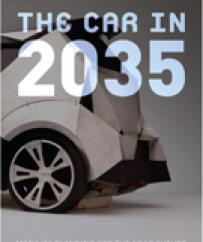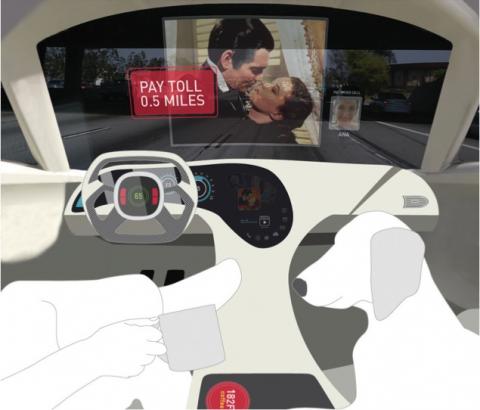Kati Rubinyi is a strategic planning consultant, researcher, and the project director of the Car Future Group and founder of Civic Projects, a non-profit that initiates and develops innovative projects through cross-disciplinary collaborations. Below TPR presents Rubinyi’s June 1 presentation at an event, “Cars, Streets and Public Policy: The Future of Southern California” at the Art Center College of Design in Pasadena, where Rubinyi presented her new book, “The Car in 2035: Mobility Planning for the Near Future.”

The Car in 2035
"The car makes for a great point of contact between design and planning because it’s an industrial design product that has implications for urban design, product design, architecture and planning: a consumer product that is accessible, banal and at the same time, eminently consequential, polarizing and controversial." -Kati Rubinyi
I’d like to begin by thanking the large number of people who made this project possible. Some on this long list are friends, family and colleagues of the Car Future Group who provided much needed encouragement at critical times. Others are here at Art Center and they provided assistance in the coordination and decision-making of all kinds necessary for making the project happen. That includes Jered Gold who organized this event.
The project also would not have been possible without generous financial contributions from Sally Kaled, The Planning Center|DC&E, Fehr and Peers, The Auto Club of Southern California, and the Art Center College of Design.
Besides thanking Art Center for financial support, I’d like to acknowledge that the diversity of disciplines at Art Center, and the built-in contrast between their motives, points of view and cultures was an inspiration to this project, and it continues to be an inspiration to my work in research and consulting, which is focused on connecting different scales, and negotiating collaborations between diverse professions that don’t normally work together.
As the book developed, my goal for it became to engage a very broad audience of readers in the aesthetically and intellectually complex relationship between cars and the physical environment. What emerged is the car framed by some kind of new mix: One that encompasses the market, social sciences, design and art, and that acknowledges the power of the image to shape the future.
I also need to mention William T. Vollman’s book Imperial. Without this book, our book never would have happened.
Our project is a book about what cars and roads in Southern California will be like in 2035. We explore both the factors influencing the design of a manufactured product, and the design and planning of the system in which it operates.
The book is divided into three distinct sections: The Car, the Street and Policy.
The sections are separated by a number of full bleed photographic images of Southern California made by artist Monica Nouwens.
These photographs make a case for the role of the visual and material culture of our present day being a force in determining, and actively shaping, our future.
The photographs and graphic design provides a strong frame of reference for the written ideas as they comingle.
The intended audience for the book is broad and includes members of the public interested in the city, people who like cars, or people who dislike cars but have a stake in knowing how they will change, and students in design and planning fields. Our goal was to create a handbook that provides a solid grounding in consensus, tempered by radical conjecture.
 The car makes for a great point of contact between design and planning because it’s an industrial design product that has implications for urban design, product design, architecture and planning: a consumer product that is accessible, banal and at the same time, eminently consequential, polarizing and controversial.
The car makes for a great point of contact between design and planning because it’s an industrial design product that has implications for urban design, product design, architecture and planning: a consumer product that is accessible, banal and at the same time, eminently consequential, polarizing and controversial.
The section on the car sets the stage with an overview of the most radical change to mobility that we’re facing: the shift toward autonomous vehicles. Over the next twenty-five years, we will increasingly inhabit an invisible landscape made of dynamic, real-time information. Eventually, your car will have awareness about the location of other cars and objects in its environment, navigating through a real-time data-scape that will only become more and more dense, fine-grained and accurate over the years and decades. You’re probably well aware from your Smart Phone that the outlines of the datascape, a full-scale map of the world in the making, already exists now.
In a steady progression, sensing and communication technology will get cheaper and more ubiquitous until, by 2035, cars will be able to drive themselves while passengers can do other things, as if they were on a train instead of driving a car.
The datascape comes into play not just when considering autonomous vehicles, but in all the sections of the book. For example the design and planning of our roadways will be informed by highly accurate, real-time traffic modeling. In considering how we will pay for the construction and maintenance of infrastructure, we learn that the ease with which government agencies and insurance companies will be able to measure and monetize individual use of our roads will inevitably lead to a more atomized and customized pay-as-you-drive method of extracting money from the users of infrastructure.
The section on cars ends with an exploration of a key aspect of the experience of mobility—arguably only latent now but one that will be sanctioned and enabled by autonomous vehicles. What we really want is teleportation—to physically appear in a different geographic location without having to engage with either space or time.
We already succeed in achieving it. Consider the paradox of the driver insulated by speed being freed up to apply make-up. This phenomenon will endure, and be legalized and legitimized once our vehicles are actually, and not just virtually, autonomous.
The idea of cars as cocoon, as a machine that we become one with, is also the theme of the book’s Foreword by Michael Webb of Archigram.
The section on The Street deals with, among other things, how planning rules and methods became biased towards the automobile. There are critiques of the profession of transportation planning, and its current assumptions and practices—assumptions that make it difficult for new types of vehicles, and for new ideas—to take hold.
This is in contrast to some radically different, new, propositions for inventive integrations between programs, such as parking, dwelling and entertainment.
Again, the topic is the latent, the virtual, and actual, coexistence between auto-mobility and any number of completely other activities or experience.
The section on policy begins with an interview with a car club in the Inland Empire, and, apart from making a case for the importance of car culture to people’s lives, it raises the issue of what the Smart-Mobility canon in planning has to offer the far-flung exurbs, where huge distances between work and housing are the norm. Here the preferred models for a good, functional city that succeeds in denser areas don’t work. This part of the world offers great questions and challenges.
This project undermines false-dilemmas, as in Cars: bad; other modes of mobility: good. Given the fact that cars are not going away, I’m hoping this book will introduce some productive, new ideas. For example, our roads will almost certainly contain a challenging mixture of vehicles of different sizes and capabilities, and the mix will be different from one part of our region to the next.
- Log in to post comments



